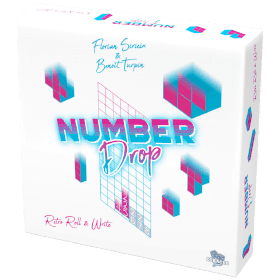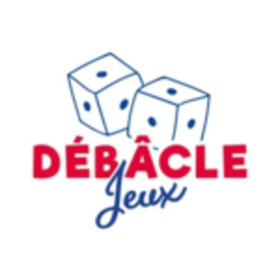Number Drop
 Number Drop is a Tetris style paper and pencil game played with numbers.
Number Drop is a Tetris style paper and pencil game played with numbers.
Players roll 4 standard dice and 1 shape die to determine the numbers they must fill in on their score sheet and the shape they must fill in. Players also have 5 block tiles they can use to block another's stack.
As in Tetris, the game ends when a stack reaches the top. The player with the highest score wins.
Number of players: 1 - 6
Game duration: 15 mn
Complexity: 3 / 5
Play Number Drop and 1194 other games online.
No download necessary - play directly from your web browser.
With your friends and thousands of players from the whole world.
Free.

Play Number Drop and 1194 other games online.
No download necessary - play directly from your web browser.
With your friends and thousands of players from the whole world.
Free.

Rules summary
For tips on how to play number drop, see Tips_numberdrop
Goal
The goal of Number Drop is to have the most points at the end of game. To do this, players compete by dropping placing numbers and dropping shapes to earn identical or sequenced number combinations.
Summary
- Place numbers and drop shapes to create combinations of identical or consecutive numbers on their grid.
- Be the most efficient and drop penalties onto your opponents!
- As soon as a player reaches the Game Over line, the game ends and whoever has the most points is the winner.
- Will you reach the ultimate score of 100?
Game Play
Each turn, both players receive the same number and shape options. Players decide how to use these options and place them on their board. At the end of the turn, these choices are revealed for other players to see.
There are 4 phases to each turn, with a possible 5th if blocking has been activated:
- Roll the Dice
- Block (if applicable)
- Drop a Shape
- Create (claim) a Combo
- End Turn (score)
Phase 1: Roll the dice
The BGA adaptation of Number Drop will handle this phase for you.
5 dice (4 number dice and 1 shape die) are rolled each turn.
- The shape die has 4 shape options and a star which represents a wild card (you choose your shape).
- The number dice contain numbers 1 - 7, as well as stars (wild). The stars may be used as any number from 1 - 7, as well as 0, 8, or 9.
If blocking was activated in the previous turn AND any of the die reveal a star, phase 2 begins. Otherwise, players proceed to phase 3.
Phase 2: Block others
- A block is a penalty shape that will hinder the opponents.
- Its activation is described in phase 4.
- Phase 2 occurs only if:
- There are active blocks circled but not crossed off AND
- There is at least one star on the dice roll (on any die).
- Otherwise, go to phase 3.
- Check all the circled blocks of all the players.
- If there are several circled blocks, only take into account the one (not crossed off) on the higher line.
- A, then B, then C...
- The other active blocks will be taken into account the next time there is a star in the dice results.
- If there are several circled blocks, only take into account the one (not crossed off) on the higher line.
- All the players that have not circled that block must then drop the corresponding shape on the board into their grid.
- The shape is composed of X's.
- It can be rotated or flipped freely, and it follows the shape placement rules.
- Once the shape is placed, it is circled.
- It cannot be used for combinations but can complete lines.
- Then, all players cross off the penalty block on their score sheets and the tile is removed from the board.
- It cannot be used again.
- Players can still create the matching combinations for scoring purposes.
- The turn is over.
- The player to the left of the first player becomes the new first player and starts a new turn on phase 1.
Phase 3: Drop a shape
- Each player, simultaneously, chooses the way they want to combine the dice (in their head) before writing down the result on their sheet:
- They must use the 4 numerical dice for their value.
- They must use those values by placing them in the shape indicated by the shape die, in any orientation. The shape can be turned and flipped:
- The stars are wilds:
- on a numerical die, each player can pick any number between 0 and 9.
- On the shape die, each player can choose the shape they want among the shapes present on the die.
Phase 4: Create a combo
- Every player can create only one combination each turn, starting from the first player.
- There are 3 types of combinations one can create:
- A combo of 3 to 7 identical numbers.
- A combo of 3 to 7 consecutive numbers.
- A bonus combo of either 8 consecutive numbers or 8 identical numbers.
- Combinations are composed of adjacent numbers on the players grid.
- These numbers must be connected without using diagonals.
- Numbers already used in other combos (and thus circled) cannot be used again.
- Consecutive numbers must be in ascending / descending order, with any starting value (not just 1).
- Players can only create one combination during each round:
- They circle the combination on the grid and on the score track.
- The value of a combination is equal to the total of numbers used in the combination.
- e.g. combination of 6 identical numbers is worth 6 points.
Block activation
- If a player creates both combos of the same size (for example 3 consecutive & 3 identical numbers), they can circle the block letter, on the right of the corresponding combinations.
- If it hasn’t been crossed off before.
- That will activate a potential penalty for their opponents.
Phase 5: End the turn
- Each player checks if they completed one or more lines with any number or X's.
- In that case, they can circle the "+2" box at the right end of each line.
- They cannot circle the "+2" box if there is a hole in the line.
- Then each player checks if they have crossed the Game Over line.
- In that case, they circle the "-5" box of each line with at least one number on it.
- The game ends immediately.
- Otherwise, the player to the left of the first player becomes the new first player and a new turn begins at phase 1.
End of the game
- The game ends when one or more players have crossed the Game Over line.
- After the turn ends:
- If a player has managed to fill an entire column of identical or consecutive number combinations, they earn a bonus of 10 points for each of these columns.
- Players add up their points for each of their combinations and their column & line bonuses.
- Each completed line is worth 2 points.
- The player with the most points is the winner.
- In case of a tie, players share a well-deserved victory!

